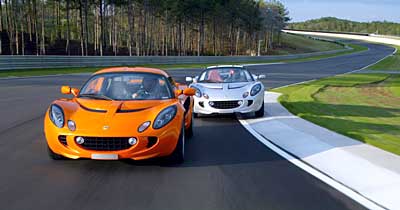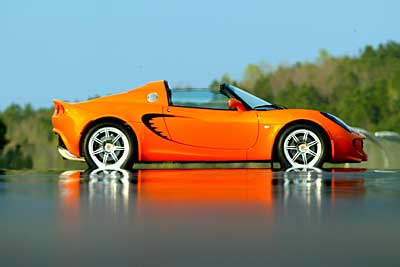A Lotus Elise
calculated just for America is coming in June -- light, legal and very fast.

By Dan Neil, Times Staff Writer
Sir ISAAC NEWTON was English, as anyone who tasted his cooking could tell you.
Catty, egocentric and quite the God-haunted lunatic in his way, Newton was also the greatest scientist before Einstein. One need only ask him, verily.
It was Newton who in "Principa" (1687) laid down the law of fast cars — though for convenience's sake he called it the Second Law of Motion, owing to the fact that fast cars had not yet been invented. It stateth: F=MA, or force equals mass times acceleration, or, if you like, A=F/M, acceleration is proportional to the force applied and inversely proportional to the mass said force is obliged to move.
Newton went on to invent calculus, explain planetary motion and attempt to transmute dog poop into gold. In these endeavors he was mostly successful.
It is a curious fact of history that different nationalities have approached the governing dynamic of fast cars in distinctive ways. The never-terribly-subtle Americans have long favored the F side of the equation — raw, stinking, fire-puking horsepower, the more the better, * la top-fuel dragsters and NASCAR stockers. Call it the Zen of the Bigger Hammer.
The arithmetically gifted Germans, meanwhile, have tended to focus on the equation itself, the function, so that each element — force, mass and acceleration — are set in elegant and optimized balance.
Newton's countrymen, on the other hand, have long been obsessed with M, for mass. The British way is to minimize mass however possible, thus creating an upward spiral of benefits. Less mass means, yes, the car can go faster, but it also means it can stop in shorter distances, corner harder and change direction more quickly because, in each case, there is less momentum to overcome.
At the same time, the stress on components is less, which means — you guessed it — they can be made ever lighter, until the breaking point of materials is reached and the car becomes a rickety piece of dog gold.

The light and the way
Which brings us to Lotus and Colin Chapman. The founding genius of Lotus Cars, Chapman — an aeronautical engineer by training — was a demon for weight savings. Chapman's technical brilliance in chassis design and aerodynamics brought the Lotus racing team 79 Formula 1 wins and six world championships in the 1960s and '70s. But the cars were notoriously fragile and could snap like a supermodel's shin. It was widely alleged that Chapman's weight-shaving obsession contributed to the fatal crash of Jochen Rindt (1970), who was declared world champion posthumously.
Chapman's road cars were likewise very quick but lacked, shall we say, a certain robustness. Consider the original Elite, which was a fantastic-handling car right up to the point where the rear shock towers punched through the fiberglass bodywork, the whole thing collapsed and caught on fire. That's a spot of bother, eh wot?
After Chapman died in 1982, the race team separated from Group Lotus and dwindled away while the financially plagued car-building operation limped on through a succession of owners, building the cool but dated mid-engine exotic Esprit Turbo. The Esprit was phased out last year after a 26-year run, an epoch in sports-car terms.
Group Lotus — comprising the carmaker and the profitable engineering consultancy — is now wholly owned by Proton, a Malaysian investment firm. For decades Group Lotus, based in Hethel, England, has been one of a common species of British car companies with never enough money to turn the corner and too much pride to lie down and die.
All that may change with the new, third-generation Elise, coming to revenue-rich America this summer. First introduced at the 1995 Frankfurt auto show and on sale in Europe and Asia ever since (20,000 copies to date), the Elise is without question one of the purest sports cars money can buy — a tiny, mid-engine rat racer, as bare as a Trappist's closet, an amphetamine on four wheels whose sensations are more akin to Japanese bullet-bikes than Porsches, Vipers and Corvettes.
Originally powered by a Rover-built four-cylinder putting out 118 horsepower, the "Federal" Elise (designed and equipped to meet U.S. crash and emission standards) is propelled by a retuned Toyota 1.8-liter inline four with VVTL-i (variable valve timing and lift), and geared with Toyota's six-speed manual transmission — essentially the Celica GT-S' powertrain reworked in a mid-engine configuration.
The new Toyota power plant produces 190 hp, pitted against the car's feathery 1,975 pounds — the lightest production car for sale in the United States. In the mechanical tug of war between force and mass, acceleration is certainly the winner in the Elise. That much was clear when journalists tested the car at the new Barber Motorsports complex in Birmingham, Ala., earlier this month, where the screaming little Elise — looking like a hybrid between an anime frog and an Irwin Allen submarine — lapped the 2.3-mile track several seconds faster than a Porsche 911.
Colin Chapman has been redeemed, and it turns out Newton may have been onto something too.
Sinewy aluminum chassis
Chapman's problem was that he was ahead of materials science at the time. The thing that makes the Elise work so well is its revolutionary aluminum chassis — the "tub" — constructed with panels of lightweight alloy glued and riveted together. The dollops of gooey red adhesive Lotus uses to build up the chassis are actually stronger than welding, which relies on narrow fused seams to hold pieces together; welding also deforms and weakens aluminum.
The chassis of the Elise weighs a mere 150 pounds and is stiffer than Churchill's upper lip. Since its introduction on the Series I Elise in 1996, this chassis construction technique has been adopted by other low-volume specialty sports-car makers, including Panoz (the Georgia-based maker of the Esperante), Morgan and Aston Martin. General Motors thought enough of it to contract Lotus to build its Opel Speedster, a variant of the Elise, sold in Europe.
All this time, gear heads stateside have been panting for a street-legal Elise (the cars have been imported for track use only). And while a U.S.-spec Elise might have seemed a no-brainer, the Lotus board didn't sign off on a federalized Elise until November 2002.
The American Elise is equipped with dual air bags, anti-lock brakes clutching huge cross-drilled AP discs, a larger gas tank, as well as niceties such as climate control, stereo and carpet — none of the latter was fitted to the first Elise I, driven in England in 1997. These add 200 pounds to the curb weight, but nobody is going to get out of the Elise thinking it's larded with luxuries.
It is, rather, the most comfortable race car I've ever driven. Poised on its double-wishbone suspension, Eibach springs and Bilstein shocks, the Elise is so communicative, so instantly available to the driver, so neuronal in feedback it's like plugging in "Matrix"-style to the road. Want to tighten your line through a corner? Breathe off the throttle, give the front tires a little more purchase, let the rear end step out a little and off you go. Want to slide sideways around the same corner like a Hollywood stunt driver? No problem.
In a way, it's like synesthesia, the LSD phenomenon in which senses merge, so you can smell sounds and hear colors. In the Elise, the physics of performance driving — weight transfer, coefficients of friction under the tires, roll centers and moments, the stuff of endless chalk talk at driving schools — are all so vivid and obvious. This is how a car is supposed to work.
Or to put it another way: This thing has more moves than a Piccadilly flea circus.
Go ahead, hit the gas
You can certainly credit the greasy-smooth Toyota powertrain, which Lotus retuned for more low-end grunt and remapped so that it switches cams at 6,200 rpm, at which point the horsepower comes on like a Birmingham fire hose. The exhaust note will set locusts to wing for miles.
Props also go to its lively and composed steering, supple ride and heroic brakes. But it is weight — or the lack thereof — that makes everything else work so well. Once, when I was in college, I took up throwing knives as a hobby, and the Elise's handy lightness and stiff balance feel in my hand just like those knives.
If you commute to work on a racetrack, this is your car. The rest of us would have to pay a price for our enthusiasm. The biggest issue with Elise is contorting ingress and egress with the top on (hard shell or canvas). Also, the Elise is by no means plush. The seats make Old Sparky look like a bean-bag chair. So, needless to say, no fat guys.
And the Steve Crijns- designed bodywork — the face of the car looks like one of those masks from Laotian folk opera — seems a trifle overwrought. In its sheer density of swoopiness, the Elise kind of reminds me of the old Opel GT.
Never mind. This is a second or third car for people who — as Lotus puts it so ably — embrace performance driving as entertainment. The car's base price is $39,985. The "Touring" package ($1,350) indulges with full leather and carpet, electric windows and an AM/FM/CD stereo with MP3 player. The "Sport" package ($2,480) offers bigger wheels and tires as well as "track-tuned" (read: bloody stiff) springs and shocks.
Lotus plans to sell about 2,200 Elises in the United States in the first model year, beginning in June, but there is capacity in Hethel to ramp up production if demand remains high (the first-year production is back-ordered). Meanwhile, Lotus designers are busy with the Esprit replacement, a mid-engine exotic that, if all goes well, will be a scaled-up, luxed-up version of the Elise.
Here's hoping the apple doesn't fall far from the tree.
(BEGIN TEXT OF INFOBOX)
2005 Lotus Elise
Wheelbase: 90.5 inches
Length: 149.0 inches
Curb weight: 1,975 pounds
Powertrain: mid-engine 1.8-liter DOHC inline four, naturally aspirated, with variable-valve timing and lift; six-speed manual transmission; limited-slip differential, rear-wheel drive
Horsepower: 190 at 7,800 rpm
Torque: 138 at 6,800 rpm
Acceleration: Quarter-mile, 13.0 seconds
EPA rating: 26.1 mpg city, 37.5 highway, 30.0 combined
Price, base: $39,985
Price, as tested: $43,230 (with sport package and $795 delivery)
Wheels/tires (sport package): 6.5Jx16 forged alloy (front); 7.5Jx17 (rear) Yokohama 195/50R16 (front); 225/45R17 (rear)
Final thoughts: Light saber
